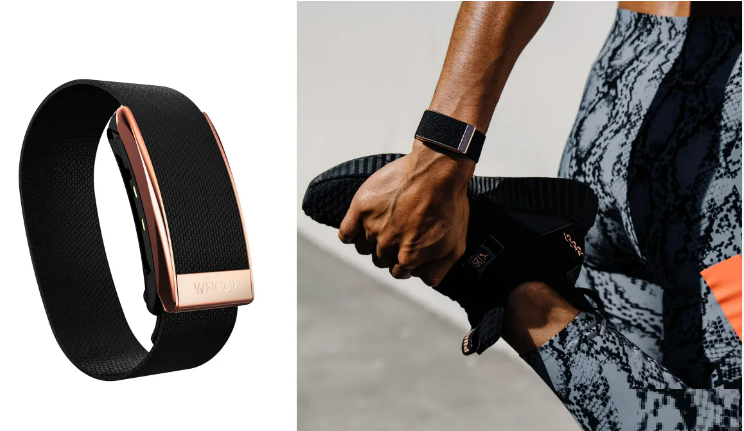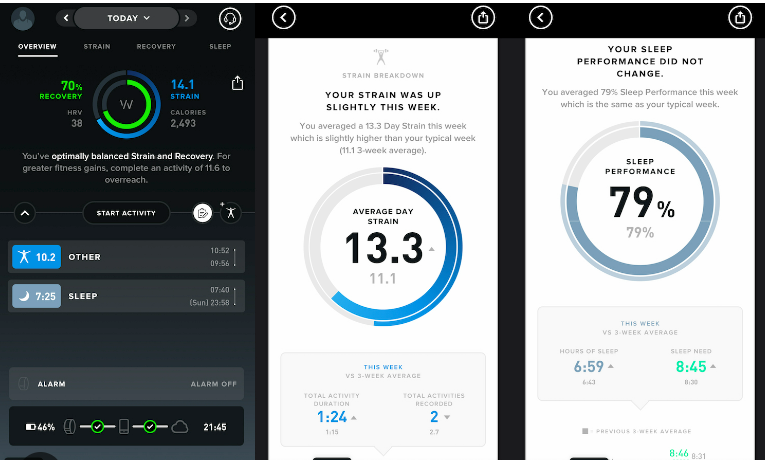If you’re someone who, much like myself, takes pleasure in maintaining a healthy lifestyle, engaging in regular workouts, and monitoring overall well-being, chances are you’ve come across the Whoop fitness tracker on your social media feeds.

Embraced by athletes, celebrities, and fitness influencers, such as Vogue Williams and two-time CrossFit Games champion Katrin Davidsdottir, and notably backed by the world’s most famous basketball player, LeBron James, this fitness tracker stands out for several groundbreaking reasons.
First and foremost, it ditches the conventional watch face, instead sending all your vital statistics directly to the accompanying app on your phone. Moreover, the metrics it tracks are considerably more comprehensive than those of a Fitbit. While Fitbit primarily monitors steps, Whoop trackers delve into what they refer to as your “fitness level,” a composite of data points including skin temperature, blood oxygen levels, heart rate variability, and resting heart rate.
Users have lauded it as a “game-changer,” so naturally, I was eager to get my hands on it and subject it to a personal trial. Could it truly revolutionize my recovery, sleep quality, and overall fitness? Keep scrolling to discover the answer, and don’t overlook our guides on the best fitness trackers and top Fitbits.
Full disclosure: I’m a bit of a fitness tracking enthusiast. I’ve been loyal to my Garmin for approximately five years, relishing the monthly improvement in my fitness score. After reading glowing reviews about the Whoop online, I was enthusiastic about elevating my fitness monitoring game. This tracker pledged to provide more comprehensive and detailed stats than its competitors.

Now, let’s talk pros: the setup was straightforward, and the battery life was decent, lasting for a few days (not the full five days as promised on the website, but a solid three to four days before needing a recharge).
One notable aspect I appreciated was its absence of a conventional watch face. Instead, I just had to consult the app on my phone to access my recovery status, sleep statistics, and more. While some may find this arrangement bothersome, I personally liked the absence of a glaring screen constantly urging me to take more steps. What’s more, a colleague pointed out that it allowed me to wear the tracker alongside my more fashion-oriented watch without appearing to don two timepieces simultaneously.
If you seek a simple device to notify you when you’ve reached your daily step goal, the Whoop, in my view, may be a tad intricate. It doesn’t actually monitor your step count or the number of stairs you’ve climbed. Tracking runs or workouts isn’t as straightforward as it is with, say, a Garmin. However, it automatically logs your workouts and provides duration based on your heart rate zone and cardiovascular strain.
The standout feature that initially caught my attention was Whoop’s daily “readiness score.” As mentioned earlier, this score takes into account a combination of your skin temperature, blood oxygen levels, heart rate variability, and resting heart rate.
In essence, the core purpose of the device is to consider your daily strain, compare these metrics with your baseline, and offer guidance accordingly. For instance, if your heart rate spiked during an intense high-intensity interval training session the previous day, and you had a less than restful night’s sleep, your readiness score would be lower. In such cases, the device would recommend a lighter day to help prevent potential injuries.
This is like a breath of fresh air in an industry that sometimes seems designed to push us beyond our limits. I’ve lost count of the times when my Garmin chastised my training as unproductive at the end of a 16-week marathon preparation, simply because I was intentionally scaling back during the taper week to allow my body to recover.
During the three months of testing the tracker, I found it genuinely intriguing to discover how long it recommended for post-session recovery. As a runner who frequently tackles interval training, long runs, and strength workouts, it made me more conscious of pacing my exercises and prioritizing sufficient recovery time.
The brand has taken a clever step by designing bras with integrated tracker slots, offering a practical option for those who want to assess their fitness without strapping on a thick black wristband. Testing this feature was enjoyable, and it’s far easier to remember to wear a bra than a watch, isn’t it?
I also appreciated the emphasis on sleep. Many trackers excel at motivating you to get up and exercise but often overlook the crucial recovery aspect of training. As someone who has shaved nearly an hour off their marathon time over the past five years, I can attest to the significant role eight hours of nightly sleep plays. I wholeheartedly support what Whoop teaches about the importance of sleep quality.
It provides a concise “sleep performance” score, and over my three months of testing, I discovered that despite spending eight to nine hours in bed each night, the quality of my sleep was surprisingly subpar. It was taking me about 45 minutes to fall asleep, and I was waking up intermittently without even realizing it. Armed with this insight, I introduced a new bedtime routine and began charging my phone in the hallway. These changes significantly enhanced the quality of my sleep and, in turn, how I felt overall.
The new Whoop 4 boasts an enhanced sensor configuration that promises greater accuracy in tracking and heart rate measurements. It’s also approximately one-third lighter than its predecessors. This smart device is proactive – even before I sense any signs of illness in mid-January, it’s advising me to take it easy and rest. For someone with a rigorous training routine, it was invaluable to know when to ease up or recognize when my body might need a slower pace.
This is like a breath of fresh air in an industry that sometimes seems designed to push us beyond our limits. I’ve lost count of the times when my Garmin chastised my training as unproductive at the end of a 16-week marathon preparation, simply because I was intentionally scaling back during the taper week to allow my body to recover.
During the three months of testing the tracker, I found it genuinely intriguing to discover how long it recommended for post-session recovery. As a runner who frequently tackles interval training, long runs, and strength workouts, it made me more conscious of pacing my exercises and prioritizing sufficient recovery time.
The brand has taken a clever step by designing bras with integrated tracker slots, offering a practical option for those who want to assess their fitness without strapping on a thick black wristband. Testing this feature was enjoyable, and it’s far easier to remember to wear a bra than a watch, isn’t it?
I also appreciated the emphasis on sleep. Many trackers excel at motivating you to get up and exercise but often overlook the crucial recovery aspect of training. As someone who has shaved nearly an hour off their marathon time over the past five years, I can attest to the significant role eight hours of nightly sleep plays. I wholeheartedly support what Whoop teaches about the importance of sleep quality.
It provides a concise “sleep performance” score, and over my three months of testing, I discovered that despite spending eight to nine hours in bed each night, the quality of my sleep was surprisingly subpar. It was taking me about 45 minutes to fall asleep, and I was waking up intermittently without even realizing it. Armed with this insight, I introduced a new bedtime routine and began charging my phone in the hallway. These changes significantly enhanced the quality of my sleep and, in turn, how I felt overall.
The new Whoop 4 boasts an enhanced sensor configuration that promises greater accuracy in tracking and heart rate measurements. It’s also approximately one-third lighter than its predecessors. This smart device is proactive – even before I sense any signs of illness in mid-January, it’s advising me to take it easy and rest. For someone with a rigorous training routine, it was invaluable to know when to ease up or recognize when my body might need a slower pace.
Now, onto the drawbacks: I did encounter instances where it took quite a while, sometimes over an hour, for the Whoop to sync the data with my phone. This delay could be somewhat frustrating, especially when you’re simply looking to check your sleep duration. Additionally, being someone who tends to break a sweat during workouts, wearing the band often left me with a damp and uncomfortable strap on my wrist.
On certain occasions, it inaccurately reported my sleep duration as only a few hours, even though I was certain I had fallen back asleep after waking in the middle of the night. Furthermore, it occasionally suggested that my optimal sleep duration should be around nine to ten hours each night, which, even for someone who values sleep like me, felt unattainable given the demands of a busy career, social life, and training commitments.
As a dedicated runner, I desired more detailed insights from my runs beyond just distance, pace, and duration. I would have appreciated a kilometer-by-kilometer breakdown or information about heart rate zones during my workouts. While I’m sure some of this data is accessible through the app, it’s not presented conveniently.
My primary concern was the overwhelming volume of data. I found it challenging, and at times nearly impossible, to navigate through the deluge of statistics provided. Unlike other wearables that package data neatly, Whoop doesn’t hold back on information. This comes from someone who genuinely appreciates fitness data and enjoys analyzing its meaning.
I recently had an insightful conversation with Anthony Fletch, a personal trainer and biomechanics expert, who co-founded One Track. We discussed how excessive data can actually be counterproductive when it comes to your fitness journey. How much data is too much? When does it become overwhelming? Is it worth canceling social events and sleeping excessively just to optimize your next workout?
Furthermore, I wonder about the psychological impact of knowing that you haven’t rested as well as you’d like to. Consider new parents who notoriously face sleep deprivation in the early years of their children’s lives. If a score constantly reminds you of how exhausted you are, do you end up feeling even more fatigued than if you hadn’t been aware of it?
Of course, there’s another perspective as well. There were certainly days when I initially felt tired but had a more positive outlook once I saw my readiness score in the green. In my experience, the Whoop tracker seemed tailored to athletes and fitness enthusiasts who thrive on intense training, and I fall into that category.
When a wearable comes with a subscription fee, like the Whoop membership, which costs around £16 per month for 24 months or £19 for 12 months, one would expect it to deliver all the valuable data Whoop offers in a user-friendly and hassle-free interface. While I enjoyed using the Whoop, I’m not entirely convinced it accomplishes this just yet.
That said, I do believe the brand is one to keep an eye on, and I’m eager to see what innovations they will continue to introduce.
